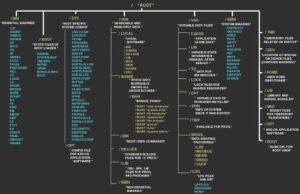 When it comes to operating systems, Linux stands out not only for its versatility but also for its well-organized file structure. Understanding the Linux Filesystem Hierarchy Standard (FHS) is essential for both beginners and seasoned Linux users. In this blog post, we will delve into the fundamentals of the FHS, explain the purpose of its directories, and discuss why it’s crucial for system administrators and developers.
When it comes to operating systems, Linux stands out not only for its versatility but also for its well-organized file structure. Understanding the Linux Filesystem Hierarchy Standard (FHS) is essential for both beginners and seasoned Linux users. In this blog post, we will delve into the fundamentals of the FHS, explain the purpose of its directories, and discuss why it’s crucial for system administrators and developers.
Understanding the Linux Filesystem Hierarchy Standard (FHS)
The Filesystem Hierarchy Standard (FHS) is a set of guidelines that defines the directory structure and directory contents in Linux operating systems. It ensures that applications, scripts, and users can reliably predict the location of files and directories. Think of it as a roadmap for where everything lives within your Linux system.
The FHS is maintained by the Linux Foundation and is a key component of Linux’s consistency across different distributions. You can find more details on the Linux Foundation’s website.
Why is the Linux Filesystem Hierarchy Standard Important?
- Consistency: The Linux FHS provides a standardized directory structure, ensuring compatibility across Linux distributions.
- Predictability: Users and applications can predict where to find system files, user data, and configuration files.
- Maintainability: A well-organized filesystem makes it easier to manage and troubleshoot a Linux system.
- Interoperability: Adhering to the FHS allows developers to create software that can run on multiple Linux distributions without modifications.
Key Directories in the Linux Filesystem
- / (Root Directory)The root directory is the top-level directory in the Linux filesystem. All other directories stem from here.
- /bin (Essential Binaries)Contains essential binary executables, such as
ls,cp, andrm, needed for basic system operation. - /boot (Bootloader Files)Houses bootloader files, including the Linux kernel.
- /dev (Device Files)Contains device files representing hardware components like hard drives and USB devices.
- /etc (Configuration Files)Stores system configuration files. Important subdirectories include /etc/ssh for SSH configurations.
- /home (User Home Directories)The home directory for user files and personal settings. For instance, /home/user1 is the home directory for
user1. - /lib and /lib64 (Shared Libraries)Holds shared libraries needed by system programs.
- /media and /mnt (Mount Points)These directories are used for mounting external storage devices and temporary filesystems.
- /opt (Optional Software)Reserved for optional software packages.
- /proc (Process Information)A virtual filesystem that provides information about system processes and hardware.
- /root (Root User’s Home)The home directory for the root user.
- /sbin (System Binaries)Contains system binaries used by the system administrator.
- /tmp (Temporary Files)Temporary files are stored here. The contents are usually cleared on system reboot.
- /usr (User Programs)This directory holds user binaries, libraries, and documentation. Important subdirectories include /usr/bin, /usr/lib, and /usr/share.
- /var (Variable Data)Stores variable data such as logs (
/var/log), mail (/var/mail), and databases (/var/lib).
Best Practices for Navigating and Managing the Linux Directory Structure
- Use Absolute Paths: When navigating the filesystem, absolute paths provide clarity and prevent errors.
- Minimize Changes to Critical Directories: Avoid modifying files in /etc, /boot, or /lib unless necessary.
- Keep Home Directory Organized: Maintain a clean and structured /home directory for better productivity.
- Monitor /var Directory: Regularly check logs in /var/log for system diagnostics.
Conclusion
Understanding the Linux Filesystem Hierarchy Standard (FHS) is essential for anyone working with Linux systems. By familiarizing yourself with its structure and best practices, you can become more efficient at navigating and managing Linux environments. What are your experiences with the Linux Filesystem? Let us know in the comments below!
